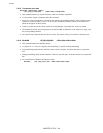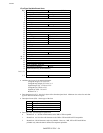10/10/03
CHAPTER 2 "PCL" - 48
5.2.14. Transparent print data
Esc&p#X (character codes)
(27)(38)(112)#(88) <1Bh><26h><70h>#<58h>
• This command enables you to print characters which are normally unprintable.
• # is the number of bytes of data that follow the command.
• Each byte of data is interpreted as a character code and the corresponding character in the currently selected
symbol set is printed (if there is one). You can use this command to print the symbols in the character set
which do not appear on the keyboard.
•
If there is no character in the current symbol set corresponding to a specified code, a space is printed.
• The command is useful when using character sets like the IBM All Character Set in which every single code
has a corresponding character.
• Any control codes within the data will have no effect. The control code byte is treated as a character code.
5.2.15. Esc&d#D (27)(38)(100)#(68) <1Bh><26h><64h>#<44h>
• This command enables the underline facility.
• # is either 0 or 3. A value of 0 signifies fixed underlining, 3 specifies floating underlining.
• Fixed underlining means that the underline is drawn in the same place for all the characters of a particular
font.
• Floating underlining means that the underline is drawn in the same place for all the characters on a particular
line.
• The command below disables the underline facility.
Esc&d@ (27)(38)(100)(64) <1Bh><26h><64h><40h>


















